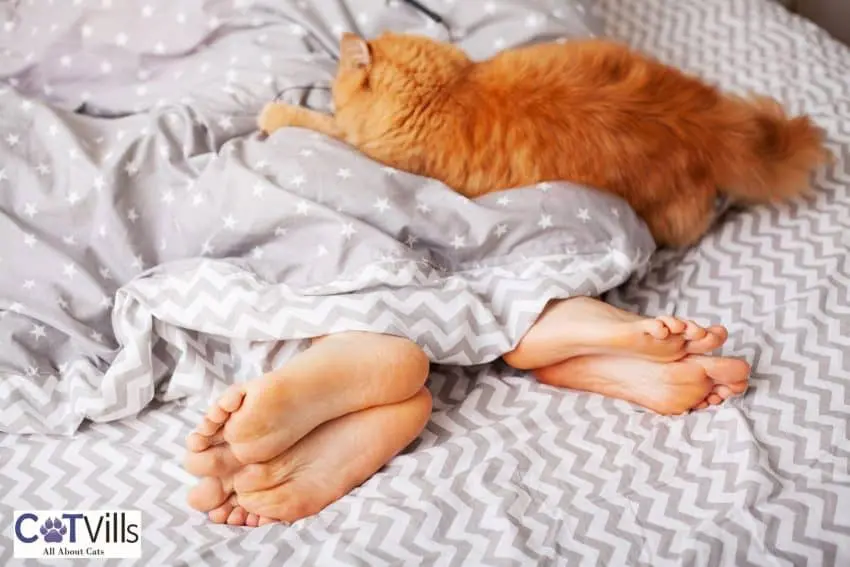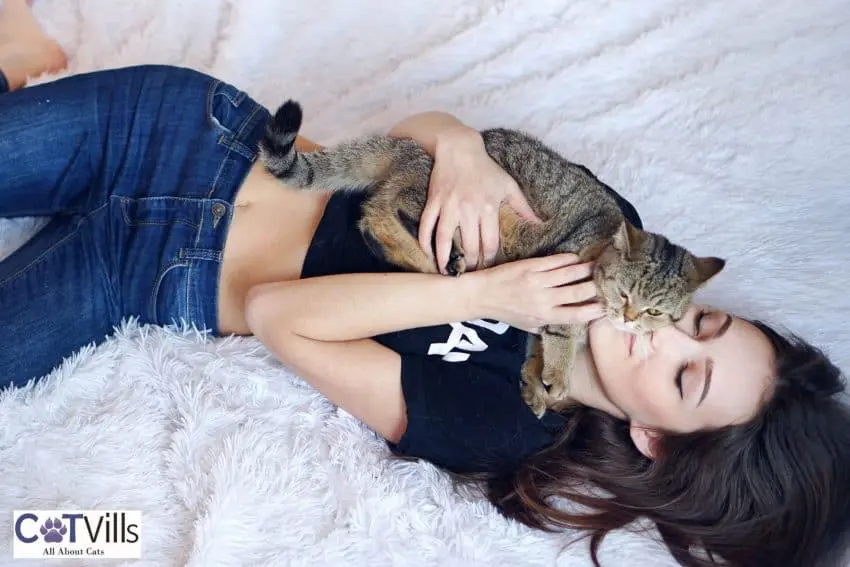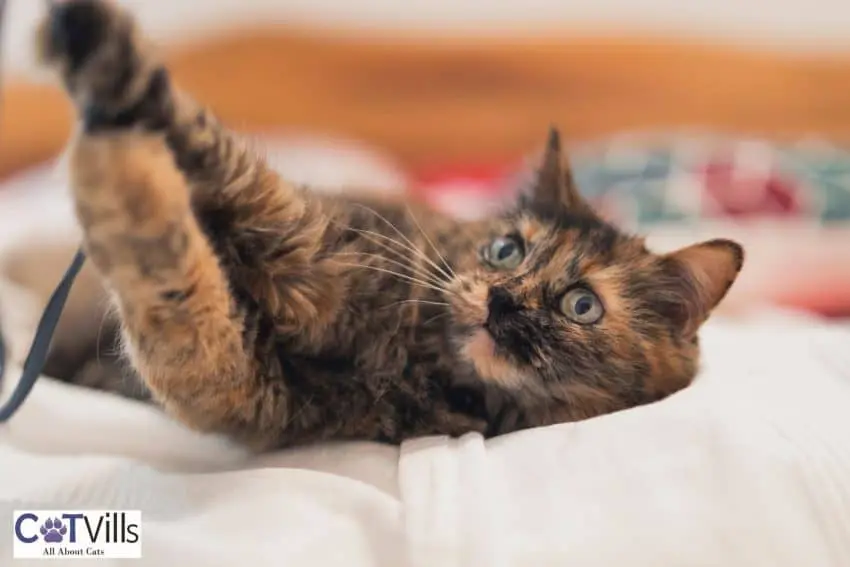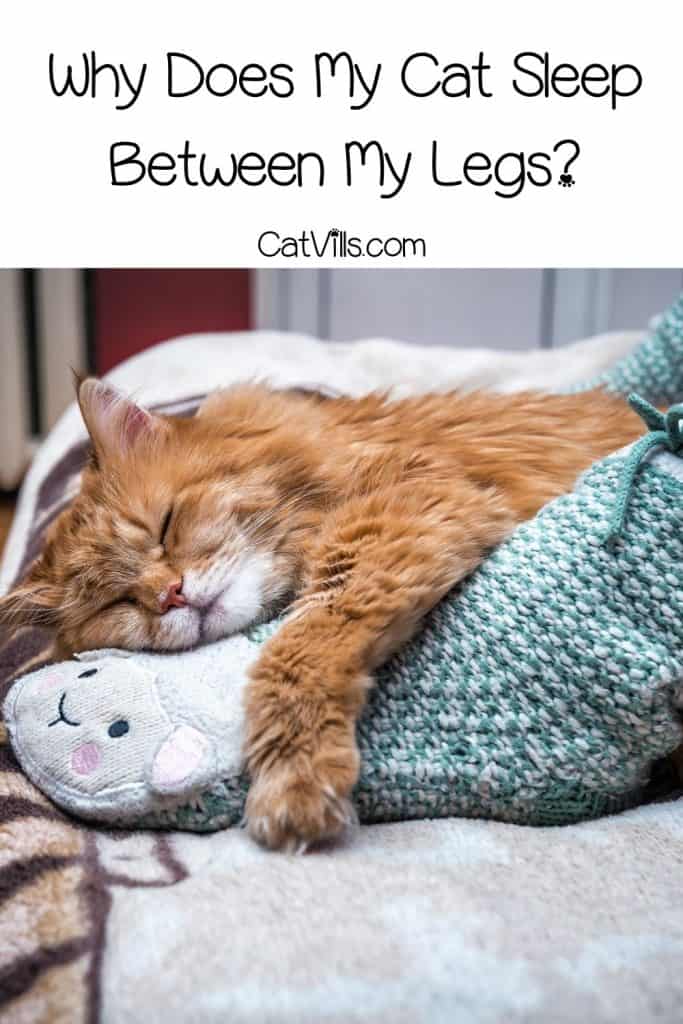Last Updated: 4 months ago
Why does my cat sleep between my legs? It is common knowledge that cats can exhibit some pretty weird behaviors.
One of them in our house is that when my cat is all tuckered out, she will come to settle herself between my legs to go to sleep.
I thought this was crazy, but it turns out she’s perfectly normal (or as normal as anyone can be in our family).
Let’s look at some of the reasons a cat may decide this is where she wants to sleep.
Why Does My Cat Sleep Between My Legs Explained
Reason 1: It’s Comfortable

Just as a cat may choose to sleep on your feet as a sign of comfort, it may also choose to sleep between your legs.
Depending on your cat’s personality, both may be deemed safe places for them to be.
It’s okay to let them sleep there if it doesn’t bother you; just be careful you don’t send them flying into the air if you decide to change positions.
It can be easy to forget that your feline friend has decided to take a nap.
Yesterday, our cat was snoozing, and I got up to refill my coffee, forgetting little Miss was sleeping between my legs.
Luckily, she has swift cat instincts and jumped up before my moves sent her catapulting into the air.
Of course, I apologized to her. All I got back was a look of pure disgust for disturbing her sleep.
Reason 2: It’s Warm
When a cat sleeps between your legs, it is seeking a warm, nest-like place to sleep.
So essentially speaking, you are like the cat’s own little heating pad. Curling up inside your legs becomes the perfect spot to envelope them in extra warmth.
Understanding that cats have slept in piles on top of each other since they were born can help explain this behavior.
They seek the warmth of body heat, and you are able to provide that for them.
A certified cat behavior expert, Marilyn Krieger, tells us, “A cat’s average body temperature is 102 degrees Fahrenheit”.
“They need to maintain heat for proper basal metabolism,” she continues, “so seeking an external heat source allows the body not to have to work so hard to stay warm while they are sleeping”.
This can also explain why friskers like to stretch out on the windowsill when the sun is at its warmest. To the cats, warmth is something their bodies crave.
Think about it: when your cat is sleeping between your legs, she is getting immediate warmth on both sides!
Reason 3: Your Cat Trusts You

You can consider it a sign that your cat has thoroughly bonded with you when they decide you are safe enough to curl up and go to sleep, since that is when they are most vulnerable.
Cats are natural predators. According to Roland Kays, a North Carolina State University scientist, even cats just moving around their backyards are significant hunters.
So they pick and choose carefully who they will decide to trust.
I think my son is the cat’s favorite in our house, but she has no qualms about curling up between my legs and going to sleep if he is otherwise occupied with typical teen things.
Is she fickle? I’m going to say no and just think instead that she is smart. If one avenue is not available, isn’t it always smart to find another? Kudos to our clever girl.
Reason 4: Your Cat Feels Safe
Your cat may simply feel safe when they get to sleep curled up between your legs. It allows them to take a cat nap, if you will, without worrying about someone coming in to bother them.
Of course, in our house, visitors sometimes bring their small children with them. They may be seeking out a kitty who clearly is not looking to be sought.
For her protection, she may curl up between my legs and expect me to shoo off the unwelcome (in her eyes) visitors. And I do, but in a very loving way, of course.
Reason 5: They’re leaving Pheromones

Yes, your cat is marking their territory. It is not uncommon for a cat to snuggle up against you and fall asleep for the sole purpose of engaging their scent glands to pass around their pheromones.
They are marking their territory and making sure everyone knows you, and the place where they live belongs fully to them.
John Bradshaw, author of “The Behavior of a Domestic Cat,” assures us that it is normal cat behavior for a cat to find a safe place and sleep between our legs.
Reason 6: It’s a Good Vantage Point
Cats are very observant and always on high alert (even when they are sleeping). They like to seek out the most likely place where they can be aware of everything that is going on in their space.
They may do this in part because they are hardwired to have hunter instincts. Dr. Radosta explains that the hunting instinct does not disappear just because a cat is lucky enough to live inside.
Settling in between your legs allows them to take in everything all at once, which is settling for them. If they can see everything going on, they can feel comfortable in their skin.
From this vantage point, they can comfortably make all of their critical cat decisions, such as: can they take a nap or is it time to bolt?
Reason 7: They Want To Bond With You

There’s a common perception that cats are aloof and apathetic, rarely showing love and affection.
On the contrary, cats are both social and affectionate, and in instances when they want to sleep between your legs, it could be their attempt to make a connection with you through pillowing.
Pillowing is a behavior whereby cats choose to curl up with one another to sleep. Individuals with more than one cat would’ve likely observed this behavior.
Additionally, cats will purr in sync during pillowing to strengthen their bond further. This behavior is often exhibited in the relationship between moms and kittens, who use this act to show love and communicate.
If your cat is the only cat in the home, chances are they are using you as a substitute instinctually.
This behavior shouldn’t be alarming, as they are likely communicating that they love you and like cuddling with you.
Reason 8: Deep Sleep
Cats will often take naps throughout the day in various spots that they feel comfortable in. That could be the bookshelf, the windowsill, the floor, the couch, the bed, and so on.
However, when they’re trying to get into a deep sleep, they’ll often look for a place where they feel especially safe so that they’re able to truly relax. Don’t be surprised if that place is snuggled between its owner’s legs.
Cats must be able to get these extended bouts of rest for several reasons. Their bodies can heal, grow, and develop during this time.
If they already thought of you as a warm and cozy space to get some shut-eye, they’ll definitely resort to cuddling between your legs when they need to regain their energy without having to be alert.
You’ll be able to tell that that’s the reason they came over because they will appear to be sleeping in a more relaxed position, seemingly unaware of and unfazed by their surroundings.
They might even cover their faces with a paw to block any disturbances, like light.
Essentially, between your legs may be their “Do Not Disturb” space. How cute!
Should you let your cat sleep between your legs?
It’s entirely up to you if you feel comfortable enough to let your cat sleep between your legs at night. Do you feel like they are safe?
Is it something you think is necessary for them to feel comfortable for the time being in your home? Has it become one of their favorite spots?
These questions and others like them vary based on each individual situation and owner. What may be the cat’s meow for you and your feline friend may not be okay for someone else.
When you should worry
There is one time when you should worry, and that is if your cat is exhibiting the new behavior of sleeping between your legs.
If this is something they have never done before, the unusual cat behavior may signify distress or a medical need.
It is always best to make a swift appointment with your local veterinarian when in doubt.
Another time you should worry is if it is during the night and you move around a lot in your sleep.
Though cats have the instincts of well-being and will likely move just in time, there are instances where they might not.
Even if their favorite sleeping spot has become you, you do not want to send your cat catapulting into outer space simply because you are a restless sleeper.
Want to Curb this behavior? What should you do?

If you don’t like your cat sleeping in between your legs, you can take measures to help:
- Shut the bedroom door at night
- Recondition them by doing constructive things to redirect them when they settle in between your legs. This can include playing, feeding them, or simply getting up and moving.
- Wrap yourself up in a blanket so they do not have access to sleeping in this spot.
There are simple measures you can take to positively recondition Kitty’s notions about where they can and cannot sleep.
Conclusion
If your cat is sleeping between your legs, it is probably because they are looking for a comfortable place or a spot—a source of warmth.
It could also be that they have a sense of security when they are close to you; they feel a sense of protection; or they simply want to find a place to rest that allows them to keep an eye on everything.
Whatever the reason, it can be a good sign of bonding that your cat feels safe enough to sleep with you.
As a cat owner, you probably already know that not everyone gets so lucky.
Resources:

Why does your cat sleep between your legs? Please share your opinion below!

Dr. Linda Simon MVB MRCVS is a locum veterinary surgeon who has worked in London for the past 8 years. She graduated top of her class in small animal medicine from UCD, Dublin. She is currently a member of the Royal College of Veterinary Surgeons. Linda is the resident vet for Woman magazine and a frequent contributor to People’s Friend Magazine, the Dogzone website, Vet Help Direct and Wag! Linda also writes content for the CVS veterinary group, Vetwriter and a number of other establishments.
